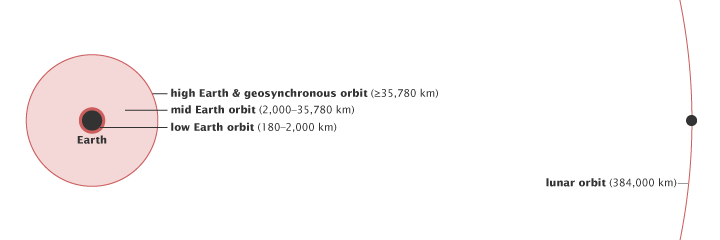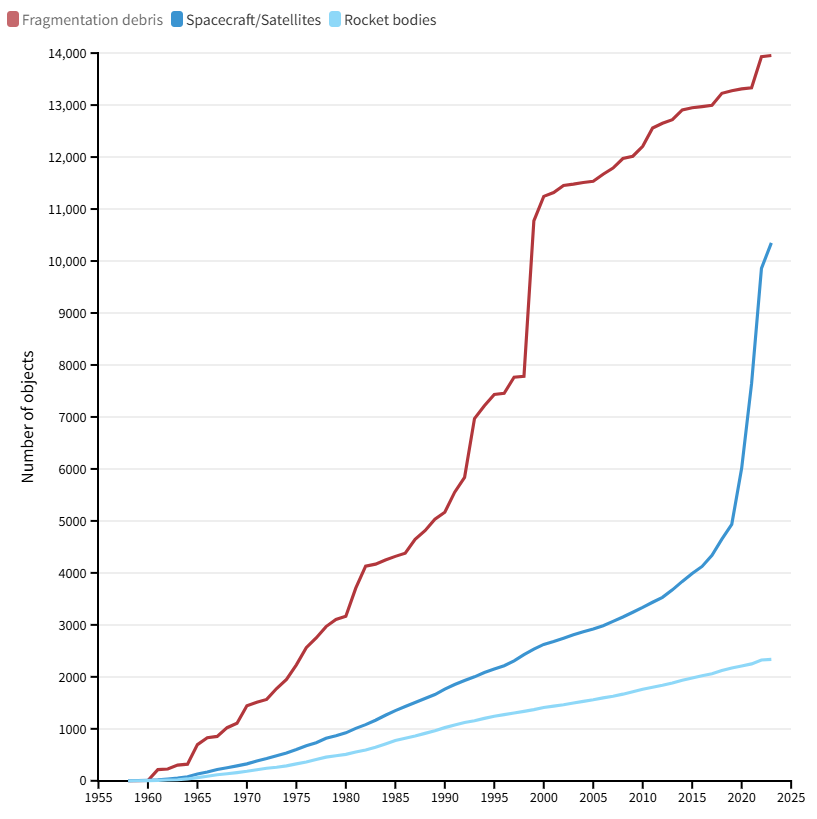Global Cooperation in Space Debris Management | 03 Dec 2024
For Prelims: Space Debris, Indian Space Research Organization, Kessler Syndrome, Inter-Agency Space Debris Coordination Committee.
For Mains: Challenges in Managing Space Debris and Way Forward.
Why in News?
Recently, the issue of increasing satellites and space debris in Low Earth Orbit (LEO) has gained international attention, with experts warning that without global cooperation, this vital region of space may become unusable.
- In October 2024, a United Nations panel on space traffic coordination called for urgent measures to address this challenge.
What is Lower Earth Orbit (LEO)?
- About:
- Low Earth Orbit (LEO) refers to an orbit around Earth at altitudes typically ranging from 180 km to 2,000 km.
- This region is closest to the Earth's surface and is the most frequently utilized orbital region for satellites, including the International Space Station (ISS).
- Orbital Mechanics of LEO:
- For a satellite to remain in LEO, it must travel at a speed of approximately 7.8 kilometers per second.
- At this speed, the centrifugal force generated by the satellite's motion balances the gravitational pull of the Earth, enabling the satellite to maintain its orbit.
- As a result, satellites in LEO take around 90 minutes to complete one full orbit around Earth.
- Unlike suborbital objects, which return to Earth, or objects exceeding escape velocity (25,000 mph), LEO objects remain in orbit indefinitely unless influenced by external forces like atmospheric drag or orbital decay.
- For a satellite to remain in LEO, it must travel at a speed of approximately 7.8 kilometers per second.
- Importance of LEO:
- Satellite Applications: LEO is preferred for Earth observation satellites, as they provide high-resolution images and data due to their proximity to the Earth's surface.
- Many communication satellites and scientific missions also utilise LEO for better transmission speeds and reduced latency.
- LEO satellites are also crucial for Global Positioning Systems (GPS).
- International Space Station (ISS): The ISS orbits in LEO, making it accessible for human space exploration and scientific research.
- Its location allows for regular resupply missions and ease of crew transport.
- Cost-Effectiveness and Accessibility: Satellites in LEO are easier and cheaper to launch compared to those in higher orbits, such as Geostationary Orbit (GEO).
- The lower altitudes mean reduced energy requirements for reaching orbit.
- Satellite Applications: LEO is preferred for Earth observation satellites, as they provide high-resolution images and data due to their proximity to the Earth's surface.
What are the Challenges Associated with LEO?
- LEO Congestion & Space Debris: The increasing number of satellites in LEO has led to concerns about space debris.
- Decommissioned satellites, broken parts, and spent rocket stages accumulate in this orbit, posing collision risks to active satellites and spacecraft.
- Over 14,000 satellites, including 3,500 inactive ones, are in LEO, alongside roughly 120 million debris fragments.
- Recent incidents, like the explosion of a Chinese rocket and a defunct Russian satellite, have increased space debris, threatening satellites and astronauts aboard the ISS.
- Collision Risk:
- Increased congestion in LEO poses risks of USD 556 million in damages in between 2024-29, with a 3.13% collision probability.
- There has also been a 17% increase in close encounters per satellite in the past year.
- Increased congestion in LEO poses risks of USD 556 million in damages in between 2024-29, with a 3.13% collision probability.
- Orbital Saturation:
- The rapid growth in satellite constellations, driven by companies like SpaceX’s Starlink (6,764 satellites) has intensified competition for orbital space, making effective regulation and international collaboration crucial.
- Management Challenges:
- Commercial Interests: Private companies, like SpaceX’s Starlink, often guard proprietary satellite data, hindering transparency and data sharing. This limits the ability to track satellites and space debris effectively.
- Lack of Standardization: Current collision avoidance methods are informal, relying on inconsistent data formats and protocols.
- This fragmented approach results in accountability issues and complicates the development of universal standards for satellite operations.
- Strategic Concerns:
- Geopolitical Tensions: Countries are often reluctant to share satellite data due to national security concerns, especially regarding dual-use satellites with both civilian and military functions.
- This reluctance complicates international cooperation and the creation of a centralized space traffic management system.
- Weaponisation of LEO: Anti-satellite (ASAT) missile tests by nations like China, USA, India (2019, Mission Shakti), and Russia (2021, destruction of Cosmos 1408) have significantly increased space debris, posing long-term risks to LEO operations.
- China’s SC-19 test generated over 3,000 trackable fragments.
- Geopolitical Tensions: Countries are often reluctant to share satellite data due to national security concerns, especially regarding dual-use satellites with both civilian and military functions.
Space Debris: Space debris refers to fragmented natural objects in Earth's orbit that no longer serve any functional purpose.
- This includes defunct satellites, spent rocket stages, and fragments resulting from collisions or other incidents.
What are the Threats Posed by Space Debris?
- Hazard to Operational Satellites: Space debris is a significant risk for operational satellites, as collisions can render them nonfunctional, disrupting vital services.
- Reduction of Orbital Slots: The accumulation of debris in specific orbital regions limits the availability of prime orbital slots for future space missions.
- Challenges in Space Situational Awareness: The rising volume of space debris complicates efforts to track and predict the movements of objects in space, making it harder for satellite operators and space agencies to maintain situational awareness.
- Kessler Syndrome: The growing number of objects and debris in space can lead to the Kessler Syndrome, a scenario where the density of debris in orbit increases, leading to a higher likelihood of collisions and further debris generation.
- For example, in 2009, a defunct Russian satellite collided with an American weather satellite, producing thousands of debris fragments.
- Kessler Syndrome counters the Big Sky Theory (1978) proposed by NASA which suggested that space debris would not pose a long-term issue due to space's vastness.
What are the Initiatives to Address Space Debris Challenges?
- India's Initiatives:
- ISRO's System for Safe and Sustainable Operations Management (IS 4 OM): It was established in 2022 to continuously monitor objects that pose collision risks.
- It predicts space debris evolution, and develops strategies to mitigate associated threats.
- Collision Avoidance Maneuvers: In 2022, ISRO successfully carried out 21 collision avoidance maneuvers to prevent potential impacts between Indian operational space assets and other space objects.
- Centre for Space Debris Research: It was established by ISRO as a dedicated center to monitor and develop mitigation strategies for space debris.
- Project NETRA: Project NETRA is an early-warning system to detect space debris and other hazards. It aims to protect Indian satellites from collisions.
- ISRO's System for Safe and Sustainable Operations Management (IS 4 OM): It was established in 2022 to continuously monitor objects that pose collision risks.
- Global Initiatives:
- Inter-Agency Space Debris Coordination Committee (IADC): Inter-Agency Space Debris Coordination Committee (IADC) was established in 1993 as an international forum that coordinates efforts among spacefaring nations to address the growing issue of space debris.
- United Nations Committee on the Peaceful Uses of Outer Space (COPUOS): COPUOS develops guidelines for the long-term sustainability of outer space activities, including measures for space debris mitigation.
- European Space Agency's Clean Space Initiative: The Clean Space initiative by ESA aims to reduce space debris and promote sustainable space activities by encouraging the development of technologies to avoid generating debris and by removing existing debris.
UN’s Five Treaties on Space Activities
- Treaty on Principles Governing the Activities of States in the Exploration and Use of Outer Space (1967)
- Agreement on the Rescue of Astronauts, the Return of Astronauts, and the Return of Objects Launched into Outer Space (1968))
- Convention on Liability for Damage Caused by Space Objects (1972)
- Convention on Registration of Objects Launched into Outer Space (1976)
- Agreement Governing the Activities of States on the Moon and Other Celestial Bodies (1979)
- India has signed all five treaties but has not ratified the Moon Agreement.
Way Forward
- Improved Monitoring: Upgrading tracking technologies and improving orbit models are vital for accurate debris detection and management.
- Enhanced Coordination: As space traffic grows, international collaboration and the creation of automated systems or "rights of way" in space can help reduce congestion and prevent collisions.
- Reducing Debris Generation: Using reusable rockets instead of single-use launch vehicles and enforcing international regulations can limit new debris production.
- India recently launched its first reusable hybrid rocket, RHUMI-1 developed by the Tamil Nadu-based start-up Space Zone India.
- Active Debris Removal: Technologies like harpoons, magnets, and lasers are being explored to capture and remove defunct space objects.
- For example, ISRO successfully deorbited Megha Tropiques-1 in 2023.
- Harpoons are specialised devices used to "hook" onto space debris for capture and deorbiting.
- Spacecraft equipped with strong magnets to attract and move debris with magnetic components.
- Directed laser beams provide small thrust to alter the trajectory of space debris, enabling controlled movement.
- For example, ISRO successfully deorbited Megha Tropiques-1 in 2023.
- Graveyard Orbit: Satellites nearing the end of their lifespan in Geostationary Orbit (GSO) should be moved to a graveyard orbit beyond 36,000 km using the last of their fuel to reduce space debris.
- International Guidelines Compliance: Strict adherence to guidelines, such as those from the International Association for the Advancement of Space Safety (IADC), is essential for managing space debris and ensuring sustainable space activities.
|
Drishti Mains Question: What is space debris and challenges posed by it. What are the ways to mitigate these challenges? |
UPSC Civil Services Examination, Previous Year Question (PYQ)
Q. International civil aviation laws provide all countries complete and exclusive sovereignty over the airspace above their territory. What do you understand by ‘airspace’? What are the implications of these laws on the space above this airspace? Discuss the challenges which this poses and suggest ways to contain the threat. (2014)


